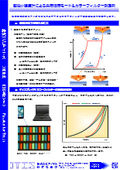Defective analysis of liquid crystal panels
We will narrow down the defective areas through lighting confirmation, panel disassembly, and optical microscope observation!
We provide a defect diagnosis menu for LCD panels, from confirming defects to identifying causes and conducting detailed failure analysis. In the initial analysis, we perform a status check (lighting test), panel disassembly, and optical microscope observation, tailored to the defect symptoms. In the detailed analysis, based on the diagnostic results from the initial analysis, we propose suitable methods such as surface analysis, cross-sectional analysis, and component analysis. It is also possible to speculate on the mechanisms of defect occurrence, including narrowing down the production processes that caused the defects. 【Analysis Content】 ■ Initial Analysis - Status check (lighting test), panel disassembly, optical microscope observation, conducted according to defect symptoms - Narrowing down from general areas such as cell panels and peripheral circuits to finer details ■ Detailed Analysis (additional analysis fees apply) - Based on the diagnostic results from the initial analysis, we propose suitable methods such as surface analysis, cross-sectional analysis, and component analysis - It is also possible to speculate on the mechanisms of defect occurrence, including narrowing down the production processes that caused the defects *For more details, please refer to the PDF document or feel free to contact us.
basic information
【Target Panels】 ■Segment LCD ■Passive LCD ■Active TFT LCD (automotive, mobile, TV, etc.) 【Items to Prepare】 ■Defective panel ■Lighting fixture (panel display defect photos are also acceptable) ■Reference panel (if available) *For more details, please refer to the PDF document or feel free to contact us.
Price range
Delivery Time
Applications/Examples of results
For more details, please refer to the PDF document or feel free to contact us.
catalog(25)
Download All Catalogs
News about this product(3)
-

Observation of Conductive Particle Shape in COG Implementation
We will introduce the observation of the shape of conductive particles in COG implementation. ICs and liquid crystal panels are implemented using the COG method with ACF (anisotropic conductive film). A resin ball is used as the core, and a metal layer (such as nickel or gold) for conductivity is deposited on its surface. During connection, the particles deform appropriately to electrically connect the IC and the panel. To confirm the degree of particle deformation and connection status, cross-sectional observations were conducted, revealing that the particle deformation was at a "medium" level, indicating an appropriate degree of deformation. By examining the deformation of conductive particles from both the planar and cross-sectional directions, we can explore the correlation with display defects. Please feel free to contact us for any inquiries regarding panel-related defects.
-

Analysis of trace metal elements in liquid crystals
We will introduce a case where ICP measurement was conducted using panels before and after reliability testing, along with quantification. The liquid crystal molecules in an LCD are oriented within the panel, and the display is controlled by changes in the orientation state of the liquid crystal due to voltage. When ionic substances, such as metal elements, are present inside the panel, the liquid crystal may not drive correctly, leading to display defects. It is known that ionic substances can increase due to contamination during manufacturing or long-term use, making it important to quantify and understand them as part of panel quality. Metal ions can be quantitatively analyzed using ICP analysis, and depending on the differences in pretreatment methods and detection sensitivity, ICP-AES and ICP-MS are used selectively. [Analysis Content] ■ Comparison of metal element content using ICP-AES analysis ■ Comparison of metal element content using ICP-MS analysis For more details, please refer to the related products and catalog below.
-

Analysis of LCD Display Materials
Liquid crystal displays use various organic materials, including liquid crystals, sealing materials, encapsulants, and polarizers. Considering the material properties and degradation mechanisms of each component from a chemical perspective is important for product evaluation and failure analysis. This document presents examples of chemical analyses for the components of liquid crystal displays. 【Examples of Chemical Analysis】 ■FT-IR: Principal component analysis ■EDX: Elemental analysis ■GCMS: Liquid crystal component analysis ■HS-GCMS: Outgassing analysis (degradation analysis) and others
Recommended products
Distributors
Aites was established in 1993, originating from the quality assurance department of the IBM Japan Yasu office. Based on the technical expertise cultivated through cutting-edge defect analysis and reliability assurance of electronic components at the IBM Japan Yasu office, we have provided various products and services that support the development and manufacturing of semiconductors, displays, organic EL, solar cells, and electronic components to customers both domestically and internationally.


















































































